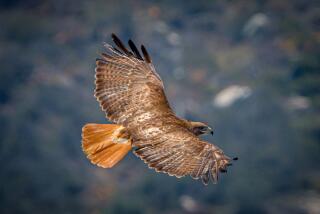Taking Page From Capistrano, College Is Now for Birds
- Share via
About 800 cliff swallows returning from South America to roost at College of the Canyons got a royal welcome Saturday from a community that once tried to drive them off with gooey repellents, sonic beepers and high-powered water hoses.
Now their presence is regarded as a feather in the cap of the school, although sidewalks, windows, building facades--and passers-by--are still fair game for their droppings.
“They’re beautiful birds, and we’ve decided to make the most of them,” said Dianne Van Hook, the college’s president. “It’s very special that they come here.”
Van Hook was a victim of a passing swallow during her first day on campus in July, she said. Her tan suit had to be dry-cleaned, but the incident did not turn her against the birds, she said.
Instead, the swallows are now viewed as an asset to the otherwise nondescript community college, just as they are to Mission San Juan Capistrano.
Welcoming Ceremony
On Saturday, about 200 people attended what officials hope will become an annual event to welcome the birds, which form colonies and make their nests in groups of hundreds along the ledges of concrete campus buildings. They will lay their eggs and tend their young until August, when they begin the 6,000-mile return to South America.
While ornithology professors gave tours of the bird colony, members of the campus biology club did brisk business selling T-shirts emblazoned with pictures of the swallows and the logo, “Even Swallows Come Home to Valencia.” Proceeds from the sales will help fund a three-year research project to study the birds’ nesting behavior, migration, mating rituals and social behavior.
Biology instructor Betty Rose said researchers hope to publish the results of studies as early as next year.
A Yale University professor and his wife have been researching cliff swallows for nearly a decade, studying such subjects as what factors cause animals to form colonies, she said.
“It’s a great educational experience, but you need an umbrella to protect you from the guano,” said Gale Hutchins, a biology student who spent last summer observing the birds and helping to band them for identification.
College officials did not always regard the birds so kindly. For 12 years, they tried devices such as beepers, stuffed owls and chemical repellents to discourage the birds from building their nests, which resemble mud igloos. One season they even used high-powered water hoses to wash down the nests every day in an effort to drive the birds away.
None of the methods worked well, and some were lethal to the birds, which are protected by federal law. In 1985, the president of the college had to pay a $500 federal fine after 12 birds died when their wings became glued together with a substance that had been spread on building ledges.
$600 Window
In 1986, the school put 2-by-10-foot panels of nylon parachute cloth along the eaves, hoping that panels flapping in the wind would force the birds to go elsewhere to build nests. When a bird got tangled in the fabric, maintenance workers had to break a $600 window to save the bird.
In 1987, officials decided to leave the birds alone and start the research project, Rose said.
“Finally, we’re proud of them,” Rose said.
So proud, in fact, that flyers promoting Saturday’s event included a poem written specially for the swallows by Dan Jacobs, a biology student at the school:
“I think that I
Shall never see
More beauty--
Than, in the swallows--at C.O.C.”
More to Read
Sign up for Essential California
The most important California stories and recommendations in your inbox every morning.
You may occasionally receive promotional content from the Los Angeles Times.













